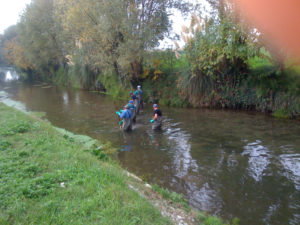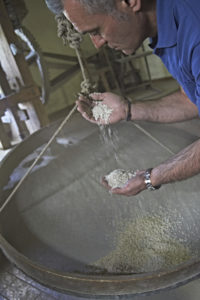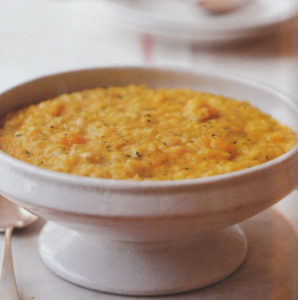The bus makes a sharp right-hand turn into a rather non-descript parking lot. We tumble out onto a scenic spot next to a small river. In the river there are three men in blue latex overalls using scythes to cut the river grass. We turn our eyes to the structure before us and the men on the tour simultaneously gasp. Before us, encased in a sleeping beauty like glass structure, lies a 1950s type 40 Bugatti. It is covered in rice dust.

We have come to see the Gazzani rice mill, one of the excursions we take our students on who take our week long course in the Veneto.. This rice mill has been in continuous operation since 1648 and still uses the mortar and pestle method that is found in only one other place in Italy. The owner, Marco Soave, comes out to greet us and quickly takes us through the modern method of rice milling that dates from the post WWII era and uses 14 machines. We climb through a rickety wall opening and see what looks like an ancient water wheel that still powers the entire factory.

After our modern tour we enter the original part of the factory. Stretched out before us are 8 applewood pestles that have never broken or needed repair. They slam into a bank of mortars made of the finest Rosso di Verona marble. Stone that back home we would only use for the most expensive counter tops. The mortars are also covered in rice dust, but they too have never needed replacing. The operation runs by a system of wooden gears and pulleys that are all attached to the ancient water wheel by a camel skin belt.
Marco stops one of the pestles. He scoops up a handful of rice to show us how the hull has been removed. He then detaches a large round sieve from the ceiling that looks like an overgrown embroidery hoop, and pours the rice into the center. He slowly moves the hoop in a circular fashion, twisting it faster and faster as the dust falls to the floor. He says he repeats the process three times before the rice is completely cleaned.

What takes 14 separate steps using the modern machines is accomplished over five hours in one step using the mortar and pestle. However, the more modern method takes only 20 minutes and the rice is polished to a shine. Later in the week we will make a risotto with it in class.

From Every Night Italian, by Giuliano Hazan, Scribner, 2000
RISOTTO AL PROFUMO DI ZUCCA
Butternut Squash Risotto
One of the many glorious dishes available in Venice in the fall is a risotto made with a local pumpkin called zucca barucca. Its aroma is rich and sweet and its deep golden color resembles the changing leaves in the countryside. In the US I have found that butternut squash most closely resembles the flavor of this pumpkin. Risotto is very easy to make. Its most trying requirement is having to stir it constantly for the 20 minutes it takes to cook and you can enlist the assistance of guests or family members to share stirring duty.
Total time from start to finish: about 45 minutes
serves 4 to 6 people
1/2 cup yellow onion, finely chopped
3 tablespoons butter
1 pound butternut squash (about 3 cups diced)
salt
freshly ground black pepper
1 1/2 cups Italian rice for risotto such as Arborio or Carnaroli
5 cups homemade meat broth, or 1 beef bouillon cube dissolved in 5 cups water
2 tablespoons Italian flat-leaf parsley, finely chopped
1/2 cup parmigiano-reggiano, freshly grated
1. Put the onion and 2 tablespoons of the butter in a large heavy bottomed pot over medium low heat. Saute the onion until it turns to a rich golden color.
2. While the onion is sauteing, remove the rind and the seeds from the squash, then cut it into 3/4 inch cubes. When the onion is ready, add the squash to the pan with about 1/2 cup of water. Season with salt and pepper and cook until the squash is tender, about 10-15 minutes.
3. While the squash is cooking, heat the broth in a sauce pot and keep it at a very low simmer.
4. When the squash is tender and all the water has evaporated, add the rice and stir until it is well coated. Add a couple of ladlefuls of the heated broth and stir with a wooden spoon. Continue stirring and adding broth to the rice as the liquid in the pot evaporates. The right amount of broth to add is just enough to produce the consistency of a rather thick soup and it is important to wait until all the liquid has evaporated before adding more broth. The rice will be done in about 20 minutes, when it is firm to the bite but not still crunchy or chalky in the center. At the end the risotto should have a creamy, almost “wavy” consistency.
5. Remove from the heat and stir in the chopped parsley, the grated parmigiano and the remaining tablespoon of butter. Taste for salt and serve at once.





2 comments
OOOOOOOOOOOO MY GOSH. I CANNOT BELIEVE IT. I FEEL TRULY HONORED THAT YOU LEFT ME A MESSAGE ON MY BLOG !!!!!!!!!!!!!!
OK…I JUST NEED TO CALM DOWN.
I HOPE IT’S OK THAT I SHARED Giuliano’S SIMPLE SAUCE RECIPE ! I think the WHOLE WORLD NEEDS to know about it !
WE LOVE, LOVE, LOVE IT !!!!!!!!!!!!!!
NOT TO MENTION MANY OTHER RECIPES IN THAT BOOK !!!!!
THANK you SO MUCH for sharing TRUE AUTHENTIC ITALIAN RECIPES !!!!!!!!!!!!!!!!!!
YOU MUST BE ONE HAPPY WOMAN……….BEING A PART OF SUCH A FABULOUS FAMILY………………………….
BLESSINGS……………
I just made this. INSANELY GOOD. Thanks again, Hazan family.